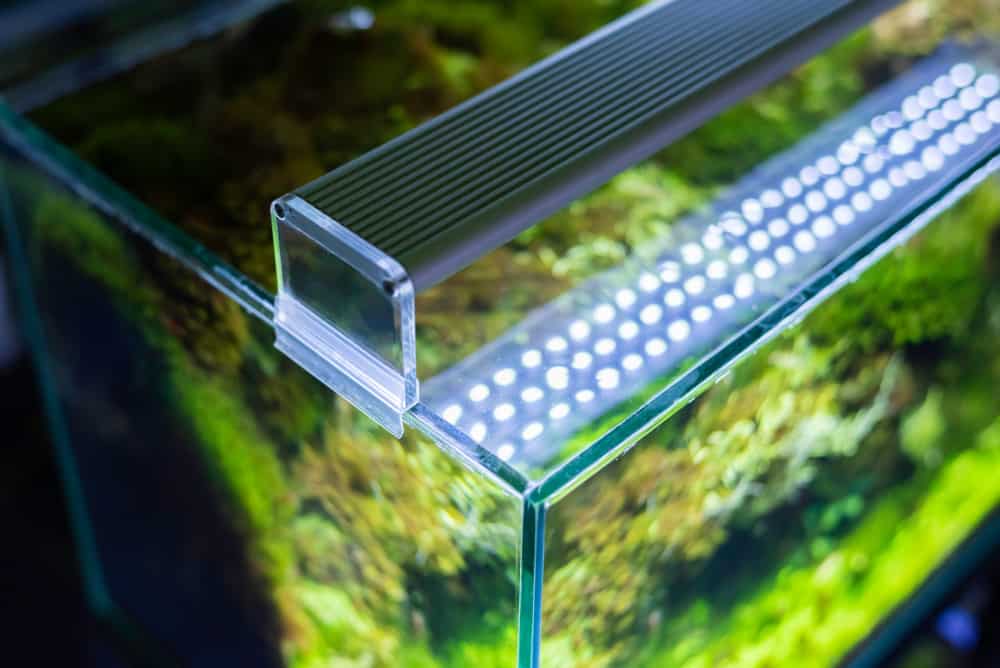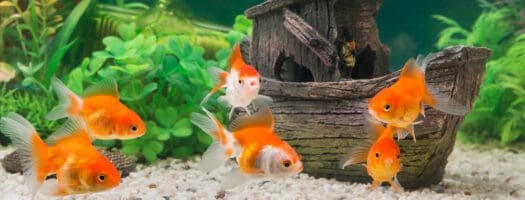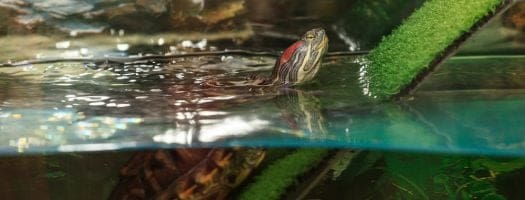The 10 Best LED Refugium Lights to Buy in 2025

Refugium lights are the quickest and safest way to speed up plant development in your aquarium tanks, helping your Chaeto plant grow and coral reefs bloom. The perfect light can even double plant growth and really help the little microalgae flourish. They’re the perfect way to give your refugium that much needed boost to take it to the next level.
- How to Pick the Best LED Refugium Light for Your Aquarium
- Top 10 Best LED Refugium Lights 2025
- 1. Best Overall LED Refugium Light: Osunby LED Grow Light
- 2. Best Premium LED Refugium Light: AquaIllumination AI Prime Reef LED
- 3. Best Budget LED Refugium Light: MingDak Crystal Glass Aquarium Light
- 4. Best Low-Wattage LED Refugium Light: Finnex FugeRay Aquarium LED Light
- 5. Best LED Light for Growing Chaeto: Innovative Marine ChaetoMax Refugium Light
- 6. Best Clip-on LED Refugium Light: Nicrew Fish Tank Clip on Light
- 7. Easiest Refugium Light to Install: Acke LED Grow Lights for Indoor Plants
- 8. Best Small-Sized Refugium Light: GrowStar UFO LED Plant Light
- 9. Best LED Refugium Light for Coral Reefs: Kingbo LED Aquarium Light
- 10. Most Customizable LED Refugium Light: Kessil H80 Tuna Flora Refugium LED
- Guide to Choosing the Perfect LED Refugium Light
- Final Words
How to Pick the Best LED Refugium Light for Your Aquarium
Using a refugium light can be essential in keeping your aquariums healthy. It helps algae, plants, and other living things grow, doing much more than just helping your aquarium look nicer. It can facilitate the photosynthesis process to really let your plants thrive, and indirectly give the tank’s filtration a boost as it keeps your micro and macroalgae healthy.
If you want a more in-depth look at refugia and lighting, check out our full guide below.
Factors to Consider When Choosing a Refugium Light
First, you’ll need to figure out the right kind of lighting to help your refugium flourish. That means understanding the type of light they might need. While your plants may grow with a little bit of care even without a quality light source, the right LED refugium lights can help them reach optimal growth rather than suboptimal growth. We’ll take a look at various components that distinguish the lights from one another in the market and which ones are better suited for various refugia.
Tank Size
The size of your tank plays a role in the types of LED lights you’ll want to use. Some are better suited for a smaller, nano-sized refugium. Others are perfect for a larger refugium that contains hundreds of gallons of water. Make sure that the light you end up picking is well suited for the size of your aquarium. It can’t be too intense for smaller tanks and shouldn’t be too weak for larger tanks.
Customizability
Some refugium lights will let you customize the output so that you can determine the wavelength or power. These are ideal since you’ll be able to tailor the light depending on how well your occupants are doing. By figuring out the perfect intensity and spectral quality, you’ll be able to use the right amount of output that fits your plants’ needs perfectly. Just remember to keep the intensity of the light in mind as LEDs will be more intense than regular bulbs, and you don’t want to overdo the lighting.
Style and Technical Design
Some LED lights are designed to focus in a specific area and are perfect for smaller tanks, but not ideal for wider areas of growth. Other LEDs are meant to be hung from above the refugium to shine directly down on it, and need a ceiling and clear area above to dangle from. Depending on the size and location of your tanks, not all LED refugium lights will work for your aquarium. Keep the design and style of the lights into account to make sure it works well with your current set up.
Find the Right CCT and Ideal Wavelength
Different microalgae, plants, and corals grow best under different colors of light. Using CCT (Color Correlated Temperature), you’ll be able to pick the LED lights that fall within your plants optimal light range. There’s more information to CCT lighting here.
However, this means you shouldn’t put as much weight on the color temperature in Kelvin of the bulbs since they don’t directly correlate to the right spectrum wavelengths. Kelvin measurements aren’t always as accurate as CCT measurements, and colors that are off won’t be able to encourage plant growth nearly as much. While some lamps cover the full spectrum of colors, they may not help with growth as much as LEDs tailored to a specific color.
If you can’t find CCT information, make sure you pay attention to the wavelengths given to know they’re perfect for your refugium. To know more about the right wavelengths to look for in lighting, you can read a more in-depth guide here.
As you can see, you’ll need to do a bit of research on your own plants to know the perfect way to light up your tank. Now that you know what to look for in refugium lights, let’s get into our top choices to light up your aquarium!
Top 10 Best LED Refugium Lights 2025
1. Best Overall LED Refugium Light: Osunby LED Grow Light
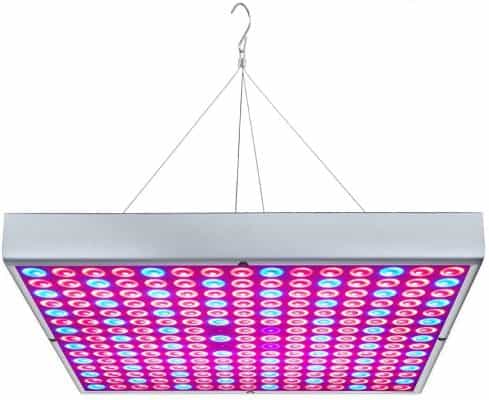
Editor’s Rating:
Why we like it: The Osunby LED light contains 225 LEDs and is one of the most affordable options for those with larger refugia. It combines four different wavelengths to help your plants and reefs grow at their optimal rate and lasts longer than most other refugium lighting options.
Quick Facts:
- Dimensions:2 x 12.2 x 1.4 inches
- Position: Hung from ceiling
- Spectrum: Red, blue, UV, and IR wavelengths
- Power: 45, 50, or 150 watts
The Osunby Grow Light LEDs have a lifespan of over 50,000 hours and can work at any temperature from 0 to 50 degrees Fahrenheit. It arrives with a hanging kit of ropes and hooks so that you can easily attach it to your ceiling. It also comes in three different sizes and LED densities, and is a relatively inexpensive LED light that’s well suited for large aquarium tanks and refugia.
However, this light is not waterproof, so you’ll want to make sure that it is suspended securely above the tank. It also doesn’t have an on and off switch, so you’ll need to manually unplug it when you want it to stop shining. It is also quite large, so you’ll want to make sure you have enough space above your aquarium to use it since it does need to hang from the ceiling.
Interestingly enough, this one LED light covers the full spectrum of colors and wavelengths, suited to help the plants and reefs through any stage of the growth process. With red, blue, UV, and IR wavelengths, it uses 225 LEDs to light up your refugium with the optimal combination of colors. The water penetration of the combined waves is enough for your tank, no matter how deep it may be, though it may be too much for smaller refugia.
Pros
- Can be used to light up larger refugia and tanks
- Over 225 LEDs in this light
- Red, blue, UV, and IR LEDs
- Over 50,000 hours of usability
- Relatively inexpensive for a larger light option
Cons
- Not waterproof
- Doesn’t have an on and off switch

Editor’s Rating:
Why we like it: The AquaIllumination LED connects to your phone through Bluetooth so that you can adjust the settings of the light even when you’re not in the room! It offers the full range of customizability on color, timing, and intensity settings, suitable for any refugium you may have.
Quick Facts:
- Dimensions:88 x 4.88 x 1.3 inches
- Position: Clipped to the side of the tank
- Spectrum: 8 different LED colors
- Power: 60 watts
The AquaIllumination LED light connects to your phone app via Bluetooth, so you can fully customize the intensity, timing, and LEDs from your phone without having to go to the tank. In addition, with 16 different LEDs and 8 different colors, you’ll be able to find the setting for the perfect wavelength.
The newest added LED wavelength is for moonlight. It’s suitable for your refugium regardless of whether you’re cultivating coral reefs or microalgae. It clips onto the side of the tank and faces the water from above. This newer design is also water resistant and won’t become damaged if it gets wet.
However, while it does connect to your phone via Bluetooth, it won’t connect through WiFi or any other method. In addition, the app can be a little clunky to use, though it’s definitely effective.
If you’re not a fan of the app but still want better control over your refugium lighting, check out the Kessil H80 light which has an associated remote control you can buy. This lighting choice is also more expensive than the other options, but it offers much more control over the specifics of the lighting as well.
This refugium light also has a defense against overheating as it uses fans to keep it cool. It’s suitable for larger tanks and smaller tanks, since the intensity of the lights can be toggled, and the mountable Prime arms are easy to use. It can also be hung from the ceiling if you want it to rise higher above your tank for better coverage, all using the Prime mounting software from the same company.
Pros
- Customizable intensity, timing, and color settings
- Connects to phone via Bluetooth
- The app makes it easy to change how the light is doing
- Suitable for coral reefs and plant refugia
- 16 LEDs with 8 different wavelengths
Cons
- Expensive option
- Won’t connect to phone via WiFi
3. Best Budget LED Refugium Light: MingDak Crystal Glass Aquarium Light
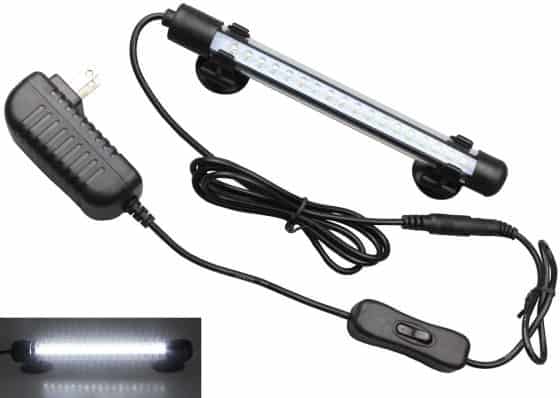
Editor’s Rating:
Why we like it: The MingDak LED light can be placed within the tank, and the submersible design allows it to be used in both smaller and larger tank sizes. It’s the best choice if you want an affordable, simple, and efficient system to help your aquarium plants grow faster.
Quick Facts:
- Dimensions:5 inch, 11 inch, 14.5 inch, or 18.5 inch options
- Position: Placed within tank on sides
- Spectrum: White or blue
- Power:5 to 4 watts
The MingDak light comes in four different sizes of varying lengths, suitable for smaller and larger tanks. The design of the bar-shaped LED lights includes suction cups so that it can be secured to the walls of the aquarium, and it will be able to light up the tank from within. The power cord itself can be easily detached so that you can turn it off at any moment, though it doesn’t have an on and off switch.
However, each MingDak light only comes in one color. There’s both a white and a blue option to choose from, but you’ll be unable to toggle between any wavelengths to find the most optimal one for your plant. If you want a smaller refugium light that comes in multiple wavelengths, you should look at the ChaetoMax refugium light.
As a result, this is unsuitable for some of the reef based refugia and best for a few plant refugia that aren’t as picky about lighting specifics. It’s also not as durable as other lighting options.
The light panels on the MingDak design can have anywhere from 18 to 57 LEDs, and because it can be stretched out over a great distance, this is a relatively inexpensive option for aquariums of any size.
In addition, while it boasts bright lights, it consumes very little power so that you won’t have to worry about your electric bill either! As it lights up the refugium from inside the tank, the lights are also brighter, and the plant will get greater benefit from the MingDak strip.
Pros
- Four size options for any aquarium
- Can be placed within the tank to provide better lighting
- Inexpensive
- Consumes very little power
- Easily detachable power cord
Cons
- Only one color and wavelength with each light
- Not as durable
4. Best Low-Wattage LED Refugium Light: Finnex FugeRay Aquarium LED Light
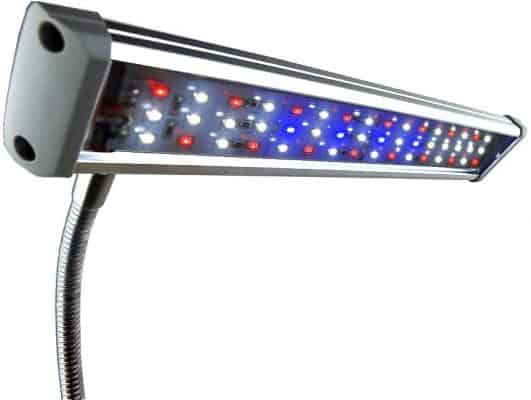
Editor’s Rating:
Why we like it: The Finnex FugeRay light is perfect for those who don’t want to worry about their power bill every month. Even as a five-watt lighting option, it still provides enough glow for large aquarium tanks, and the LEDs are able to be used for over 40,000 hours.
Quick Facts:
- Dimensions: 10 x 2.5 x 9.5 inches
- Position: Clipped on to the side of the tank
- Spectrum: 660 nm red light and 420 nm blue light
- Power: 5 watts
The Finnex FugeRay aquarium light is meant to last over 40,000 hours of use. Paired with the fact that it only needs five watts of power, and you realize you have a durable option that won’t cost too much on your electricity bill.
The light is stronger than other clip lights and can be used to light up larger sized aquariums, and its adjustable gooseneck gives it a range of angles that it can be used in.
However, for some refugium tanks, this light may be a little too big or intense. In addition, this aquarium light is not waterproof, meaning it may break if too many droplets end up landing on it. A more water resistant option would be the AquaIllumination AI LED light.
Unlike other options, this light also gains heat when powered for a long period of time due to its greater power and size. This is because the material is a combination of both plastic and aluminum.
But if you have a large refugium with microalgae and Chaeto plants, the LEDs of the Finnex FugeRay light is perfect when it comes to encouraging growth. With red and blue colors blended together, you’ll be able to see an improvement in plant growth very quickly. In addition, the LEDs combine in different ways to create red light, a white light, and a blue ‘moon’ light that’s been shown to encourage growth.
Pros
- Only needs five watts
- An affordable option for larger refugia
- Lasts over 40,000 hours of use
- Easily clipped to the side of the tank
- Blue and red LEDs encourage plant growth
Cons
- Not waterproof
- Heats up when used for long periods of time
5. Best LED Light for Growing Chaeto: Innovative Marine ChaetoMax Refugium Light
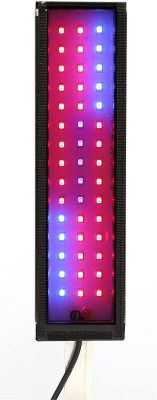
Editor’s Rating:
Why we like it: The ChaetoMax LED lights were created to help Chaeto plants grow as quickly as possible, and uses a blend of four wavelengths to boost growth. The light itself takes up very little space and can easily be mounted on the side of the tank, making this process much simpler for you.
Quick Facts:
- Dimensions:7 x 1.85 x 0.39 inches
- Position: Mounts to side of the tank
- Spectrum: 5 LED colors, from 420 nm to 660 nm
- Power: 9 or 18 watt options
With over 45 LEDs in the ChaetoMax, it optimizes the combination of four different wavelengths of light to help your Chaeto plant grow. These wavelengths include a 660 nm red light, a 630 nm magenta light, a 470 nm violet light, and a 420 nm blue light. It can be directly attached to the side of the tank and comes with included mounts to make the installation process easier.
However, this refugium light is not waterproof, so make sure you don’t place it inside your tank. In addition, the light itself is not very big and doesn’t reach as far. If your refugium is taller than 6 inches, the light won’t be strong enough to help your Chaeto plant reach maximum growth.
If you do want a smaller, inexpensive lighting option that reaches further, check out the MingDak light which can be submerged in the water to help with lighting.
The design and creation of the ChaetoMax were tailored to help sumps and refugia reach optimal Cheato growth, though many other microalgae will grow until this light as well. In addition, it doesn’t have an issue with heating up when used, which is important as it is placed directly on the glass walls. The 18-watt option is larger, making it perfect for bigger refugia, and comes with twice as many LEDs.
Pros
- Created solely to help Cheato plant reach maximum growth
- Easy to mount to the wall of the tank
- Blend of four different wavelengths to help microalgae grow
- Comes in two different sizes
- Won’t heat up after extended use
Cons
- Not suitable for larger refugia
- Not waterproof
6. Best Clip-on LED Refugium Light: Nicrew Fish Tank Clip on Light
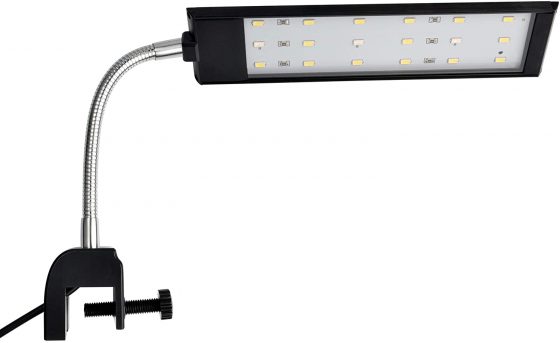
Editor’s Rating:
Why we like it: The Nicrew clip-on light is perfect for smaller refugia that don’t have much free space above them. The light comes with two different settings for daytime and nighttime and is easily secured to the walls of your tank. With an adjustable arm mount, it’s able to bend at any angle for lighting.
Quick Facts:
- Dimensions:6 x 2 inches, with 5.2 inch flexible neck
- Position: Clipped to the side of the tank
- Spectrum: 21 white and 6 blue LEDs
- Power: 7 and 10 watt options
The Nicrew clip-on light can be securely attached to one side of your tank and has multiple blue and white LEDs to simulate sunlight. The adjustable arm mount lets it be bent at any angle so that it can light up the tank as needed. As long as the sides of your tank are less than 0.9 inches thick, the Nicrew clip-on light can easily be secured.
However, this light is very low-wattage and power, and can only be used for smaller tanks. Think under 5.5 gallons. Yeah. That small. If you do have a larger tank, one option is to buy two or more of the Nicrew clip-on lights, since they’re one of the more inexpensive options, and clip multiple to the sides of your tank.
Unfortunately, it also doesn’t have any extra wavelengths and colors for you to choose from besides the two.
For its small size and power, it lights up enough of a nano refugium to encourage microalgae growth. In addition, as this light doesn’t need to be hung from the ceiling, it’s much easier to set up than many other options available on the market. While it doesn’t have a timer or dimmer for the light settings, the intensity is not strong enough to end up burning any of your plants.
This light also has two settings to replicate daylight and nighttime environments. During the day, all 27 LEDs can be powered, and during the night, only the 6 blue LEDs can be powered, so that your plants get used to the day and night cycle they would experience in nature. If you want a clip-on refugium light with red and blue LEDs, check out the Finnex FugeRay light.
Pros
- Two light settings for daylight and nighttime
- An inexpensive option for refugium lighting
- Adjustable arm mount lets it be bent at any angle
- Installation brackets let it fit walls up to 0.9 inches thick
- Can be easily clipped on to any wall of the tank
Cons
- Only suitable for tanks around 5.5 gallons
- Doesn’t offer other color choices
7. Easiest Refugium Light to Install: Acke LED Grow Lights for Indoor Plants
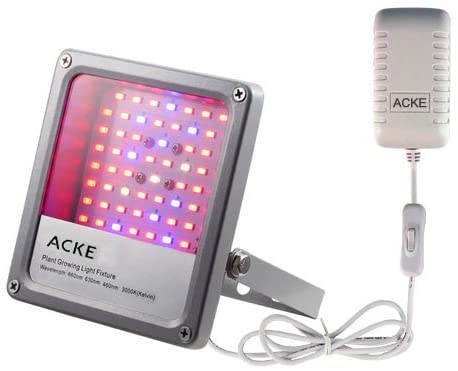
Editor’s Rating:
Why we like it: The Acke LED grow lights have three different ways it can be set up, so that you don’t necessarily need a large open area above your tank. For smaller plant refugia, the wavelengths and intensity are right in the sweet spot to help Chaeto and other microalgae grow.
Quick Facts:
- Dimensions:7 x 4.7 inches with 5 inch stand
- Position: Can be placed on a flat surface, fixed to the wall, or fastened to a bar
- Spectrum: 460 nm, 630 nm, 660 nm, and white light
- Power: 12 watts
The Acke refugium light can work for your aquarium, no matter what set up you might envision. It can be clamped onto a bar above the refugium, screwed to the wall beside the refugium, or even just placed on a flat surface close by. For a low wattage light, it also produces enough light to take care of a smaller sized aquarium. If your tank contains more than 30 gallons of water, you may need to look into a more powerful light.
However, keep in mind that the diodes are mostly in red and blue wavelengths, with a white light option as well. This is more suited for plants in the refugium than anything. You won’t be able to get the versatility that some of the other options have since it has less color and wavelength choices.
If you are interested in a more customizable option for smaller refugium light, you’ll want to take a look at the GrowStar LED light. Unfortunately, just like some of the other smaller lights, there’s no choice to dim or reduce the intensity of the light if it proves too powerful for your plants.
The set up for this refugium light is easier than most since you don’t need to dangle it above the tank. With a completely rotatable bracket, you’ll be able to get the perfect angle to light up your tank. In addition, due to the aluminum material, the light also doesn’t heat up too much and won’t accidentally burn any of your plants.
Pros
- Can be used in any aquarium set up
- Rotatable bracket lets you adjust the angle as needed
- Aluminum material doesn’t heat up
- Spectrum choices are good for microalgae and plants
- Produces enough light for being so low-wattage
Cons
- Less color and wavelength options
- Cannot adjust the intensity of the light
- Shouldn’t be used for tanks larger than 30 gallons
8. Best Small-Sized Refugium Light: GrowStar UFO LED Plant Light

Editor’s Rating:
Why we like it: The GrowStar UFO refugium light comes with 12 wavelengths to choose between, and it shines more intensely than many of the other smaller lights. You won’t need much free room above your tank, since this refugium light is perfect for those who want a customizable light in a smaller size.
Quick Facts:
- Dimensions:9 inches diameter, 2.4 inches height
- Position: Hung from the ceiling above the tank
- Spectrum: 380 nm – 760 nm, and white light spectrum
- Power: 150 Watts
While the GrowStar LED is another small LED light, this one has more power than most of the other small lights. You’ll be able to easily hang this one up even if you don’t have a lot of overhead space, and the full spectrum of 12 different wavelengths lets it be used for any sort of refugium, a sort of customizability better than most other LEDs that are the same size. The CREE LED chips have higher quality light generation, and the red and blue light combo can help a Chaeto plant grow quickly.
However, this light doesn’t have a timer on it, so you’ll have to manually turn it on and off. In addition, you won’t be able to dim the lights either if it is too intense for your plants, though you can get around this by hanging it higher over the aquarium.
Unlike some of the other refugium lights, the GrowStar is not waterproof, so you’ll have to make sure you hang it securely. If you’re worried about the process of setting it up, you could look at one that’s a little more versatile about where it’s placed, such as the Acke grow lights.
It also comes with a kit to help hang up the light, and a power cord to connect it to the nearest outlet. The fan is also very quiet and not distracting in a home environment. In addition, the refugium light was built to last.
Pros
- Twelve choices for color and wavelength
- Included kit for hanging up the light
- More powerful than many other smaller sized refugium lights
- CREE LED chips generate higher quality light
- The fan is quiet and unobtrusive
Cons
- No timer in the light
- Not waterproof
- Cannot dim the light intensity
9. Best LED Refugium Light for Coral Reefs: Kingbo LED Aquarium Light
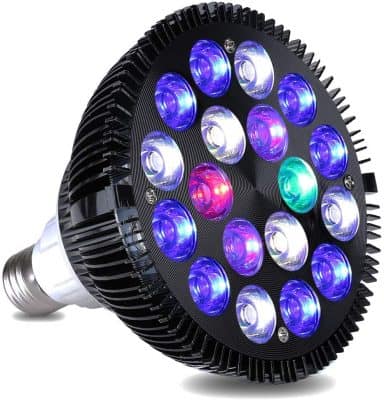
Editor’s Rating:
Why we like it: The Kingbo aquarium lights come with six different wavelengths which can help coral and plants grow in the refugium. With blue and green colors to choose from, this light is especially tailored towards helping reefs develop, and is a solid choice for any aquarium you may have.
Quick Facts:
- Dimensions:7 x 4.7 x 4.5 inches
- Position: Hung above the tank
- Spectrum: 630 nm, 520 nm, 460 nm, 420 nm
- Power: 18 watts
The Kingbo refugium light is best for helping coral growth in the refugium and comes with six wavelengths to toggle between so that you can change color as needed. It helps with UV, blue, red, green, and white lights. In addition, the end is a screw so that it can fit in most light bulb fixtures (it fits E26 and E27 sockets). While the wavelengths are more tailored towards reef based refugia, it can also be used for sumps and plant aquariums.
However, you’ll be on your own when setting up the system for this lighting choice. First, you’ll need a lamp or holder with an appropriate socket, so that you can hang the light about a foot above the aquarium. In addition, since the bright white light doesn’t come with any yellow lights, it can be a little too intense for plants if it is too close to the surface of the aquarium.
You’ll definitely need to do some research before purchasing this LED light since you’ll have to decide which color is the best on your own. If you just want a simple option for your Chaeto plant, definitely look at the ChaetoMax refugium light so you won’t have to do as much research. It also keeps at a constant temperature even after a day of continuous use due to the aluminum it’s made of, which helps increase its lifespan. After all, with a 12-month warranty, you can be sure that the Kingbo aquarium lights are made to last.
Pros
- Suitable for coral and plant refugia
- Six choices of wavelengths for color
- Durable option with a twelve-month warranty
- Fits in common light fixtures
- Doesn’t heat up too much due to aluminum material
Cons
- Lights may be too intense if too close to the aquarium
- Need a separate lamp and set up system to use this light
- Not a good choice for beginners
10. Most Customizable LED Refugium Light: Kessil H80 Tuna Flora Refugium LED

Editor’s Rating:
Why we like it: The Kessil H80 refugium light was created to help Chaeto plants and other microalgae grow at their optimal rate. With a low-wattage LED that provides the perfect amount of light, it comes with four choices within its spectrum so that you can pick the best color combination for your refugium.
Quick Facts:
- Dimensions:88 inch diameter, 0.98 inch height
- Position: Held above the tank
- Spectrum: IR, UV, and 360 nm to 780 nm wavelengths
- Power: 15 watts
For smaller refugia with Chaeto plants, you can’t go wrong with the Kessil H80 LED! It covers four different colors in its spectrum, including red, blue, bloom, and grow, and the choice in spectrum lets you tweak the LED light to the perfect wavelength for your plants. You can dim it when needed and it operates silently, unlike some of the other LED lights.
Unfortunately, the coverage only ranges from 14 inches to 24 inches, meaning it won’t be big enough for a larger tank. If you do have a huge refugium, you’ll want to invest in the AquaIllumination AI light which is another customizable option that is more intense for large tanks.
For this light, you’ll also need to purchase the Kessil Spectral controller as well if you want access to the full range of customizability and figure out positioning on your own. In addition, the wavelengths are more suited for microalgae and plants rather than coral.
This LED itself is very low-wattage but produces enough light to hit the perfect spot for plant growth. That means that you won’t have to pay as much on your electric bill while your Chaeto still has optimal growth! If you’re just starting out with your Chaeto plant and don’t know the optimal settings, you can simply choose the “Grow” option in the spectrum and it’ll do the work for you.
Pros
- Four spectrum settings
- “Grow” setting is the optimal wavelength for Chaeto plant
- LED light is low-wattage and needs very little power
- Perfect intensity for smaller refugia
- Customizable options for more advanced refugium owners
Cons
- Need to buy the spectral controller separately
- Doesn’t come with a set-up system or a gooseneck
- Not enough coverage for a larger tank
Guide to Choosing the Perfect LED Refugium Light
When it comes to the right LED lights, it all depends on what you have in your tank, and what you’re hoping to grow. Some designs are best for smaller tanks, while others can light up tanks with hundreds of gallons of water. First, we’ll need to get deeper into the science of why LED lights work, so you know which ones are best tailored for your aquariums.
Introduction to Refugia and Refugium Lights
Your plants need light to photosynthesize and create energy. However, in your home aquarium, they might not be in view of the window throughout the day to soak up some of the light energy. During the long nights, they certainly won’t get any light at all! In addition, when photosynthesis stops, your microalgae stops converting carbon dioxide to oxygen, leading to increased CO2 levels as well, which can mess up the pH (acidity) of the tank.
The best method to keep your plants photosynthesizing and growing is by using an LED light whenever they don’t have access to natural sunlight so that your pH and carbon dioxide levels in the tank remains constant. With extra light helping your plants grow, you’ll see them thriving in no time, much better than they would be doing in the dark!
What Are Refugia?
Refugia are small aquariums that are part of a saltwater or reef aquarium. Usually, some of the smaller and more delicate species in your aquarium grow in them, such as microalgae and coral. They can also help cycle and filter the water in the tanks, and normally include a sand or mud bed. While fostering delicate fish and coral species, it can offer oxygen after sundown through the use of a refugium light and maintain the pH of water.
They can also add natural food sources into the current tank, such as phytoplankton and zooplankton. In addition, studies have shown that the macroalgae commonly in refugia are able to boost the immunity system of certain fishes, all while adding to the aesthetic of the overall tank! Just by having a refugium, your aquarium will be more balanced with fewer changes in the water from day to day due to the natural filtering process of the plants grown.
How Long Should I Use a Refugium Light Throughout the Day?
Refugium lights are normally used for eight to twelve hours in a day, though it varies from tank to tank. Some leave them on for 24 hours so that growth and photosynthesis are continuously happening at the most optimal rate. This is for people who don’t every use aquarium display lighting.
Others alternate – they’ll put on the refugium lights whenever the displaying lighting is turned off and using display lighting when the refugium lights are off. Often, they’ll overlap the lighting for one hour in the morning and one hour at night, to help provide a more stable environment and get plants adjusted to the switch in lighting. This way, their plants are never in the dark. Regardless, keeping refugium lights on for too long certainly won’t hurt growth.
In addition, some lights have a nighttime and daytime light setting, to better replicate the wavelengths they’d get from the sun and moon in the wild. Our favorite one with these settings would be the Nicrew clip on light.
If your light has these settings, feel free to keep it on for most of the 24 hours in a day, and make sure to switch between the two light settings when it is appropriate.
You can read more about refugium lighting schedules here.
How Much Light Is Optimal for My Refugium?
This answer is dependent on the plants that you have growing in the refugium. All plants have this “maximum efficiency” at which they can operate, which is how much light they’re able to process in a given amount of time. Their chloroplasts can only work so quickly, and exceeding this capacity could end up injuring the plant. However, with most available LED lights, you probably won’t hurt them – but they won’t grow optimally either.
In addition, the amount of light you need also depends on the penetration of the light. Different wavelengths penetrate water differently, so you’ll need higher intensities for certain colors so that it can reach the bottom of the tank.
This means that any film algae, sediments, or other objects that could cloud the water can also decrease the amount of light that actually makes it to your plants at the bottom of the tank. When purchasing, make sure that you account for tank depth and water quality!
For smaller sized tanks, we would definitely recommend the Kessil H80 light as a customizable option for lighting to pick the right wavelengths.
For larger tanks, we’d recommend the AquaIllumination AI LED light to fully light up the tank.
Plant-Based vs. Reef-Based Lighting
Depending on the type of growth you have in your refugium, you’ll need to base decisions on their different needs. Refugia filled with plants such as macroalgae (chaetomorpha, caulerpa, etc.) have different preferred lighting when compared to corals in reef refugia. We’ll take a look at the main differences below.
Plant-Based Refugia
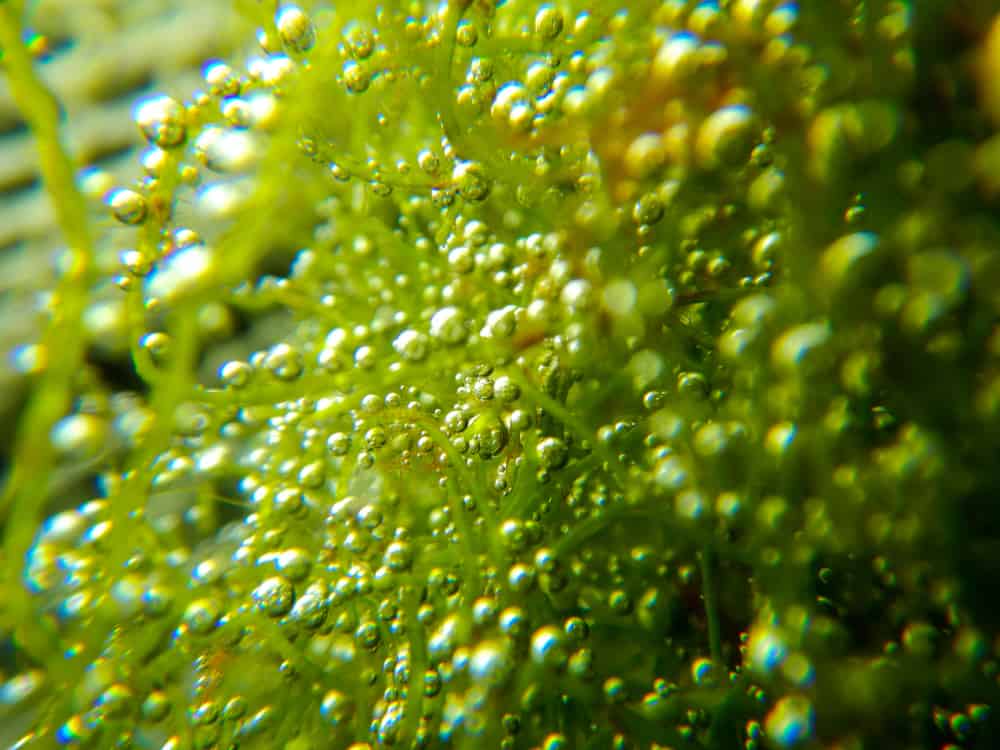
Plant-based refugia grow the best under natural sunlight, so you’ll want to find LED lights closer to the red and yellow end of the visible spectrums (though some grow well under blue lights). It can be easy to over or under light the systems, so take care when you look at the CCT or given Kelvin measurements.
The plants most often used for filtration in these refugia are often based close to the surface of the water, which is why they’ve adapted to grow best under ranges close to sunlight, preferably in a dark red hue.
Our favorite LED light for a plant refugium would be the ChaetoMax refugium light, which is designed specifically for Chaeto plants but can be used for a variety of species.
Reef-Based Refugia

When it comes to coral reefs, they can be found close to the surface or many meters below. As a result, refugia with coral reefs have a much larger range of intensities, wattage, and colors that they can grow well under just from the way they’ve evolved. They thrive more under blue and green lights rather than red lights.
You may want to look into specific wavelength intensities for certain types of coral you may have, and just keep a lookout for LED lights that are higher on the wavelength spectrum. Our favorite LED light for refugia that hold coral reefs would be the Kingbo lighting system, which encompasses a large variety wavelengths.
Best Wavelengths for Growth and Water Penetration
If you’re not much of a science person, all this talk about wavelengths could get a little confusing. Which colors should you look for when you first make that investment for your refugium? As it turns out, the two main factors are the depth of your tank and the plants that you’re growing.
Water Penetration
Below is a chart of the colors, wavelengths, how far they penetrate the water.
| Color | Wavelength | Penetration Depth |
| Red | 650 – 780 nm | 3 to 5 meters |
| Orange | 585 – 650 nm | 13 to 16 meters |
| Yellow | 575 – 585 nm | 27 to 32 meters |
| Green | 490 – 575 nm | 43 to 50 meters |
| Blue | 380 – 490 nm | 57 to 61 meters |
As you can see, red light has the weakest penetration in water when compared to blue light. If you want to use a red light, you’ll want it to be a little more intense to get more of it to your refugium. This also means that if you have a deeper tank, you’ll want more LEDs in your lighting choice so that enough light will make its way to the plants.
Finding the Right Wavelengths for Your Plants
First, you’ll need to figure out the type of plants or coral you have in your refugium. Then, you’ll need to figure out where they reside in the natural environment. For example, the most common algae grown in refugia would be chaetomorpha, a green macroalgae. This means that it lives closer to the surface of the water, and is more used to direct sunlight.
Taking a look at the chart, you’ll notice that red wavelengths also have the lowest penetration depth, meaning that they’ve been exposed to red hues in the wild. Then when you’re looking for a LED lighting system for it, you’ll want to make sure it includes red wavelengths so that it can benefit the Chaeto plant.
For any other plants, you’ll want to do the same. Figure out where it resides in the wild, and see which wavelengths it would’ve been exposed to. These are the wavelengths that it has evolved to prefer, so you’ll want to make sure any lighting choice you pick includes them.
Some wavelengths also help specifically with growth and blooming, which you can read about here.
Tips to Help Your Reef Tank Thrive
If you have a reef tank, you’ll know that coral is much more delicate than plants, and need a lot more care. To make sure you help your reef grow and develop beyond what a refugium light offers, here are some tips to get you started with your coral reef.
Go Big or Go Home!
When it comes to a reef tank, the bigger ones have a higher chance of success. Go for the biggest one that you can fit in your home to help balance the environment within. You’ll be able to fit more fish in as well, and death rates significantly decrease as the size of the tank increases. Some refugia and tanks can even have over 80 gallons of water!
Test Water Quality Often
Coral can be sensitive to any change in water, so you’ll want to maintain the pH and chemistry that best helps them thrive. While plants are more resilient, they grow the best under stable conditions that they’re accustomed to. You should aim to check the quality and pH of the water weekly to make sure that it hasn’t deviated too far.
Make Plans Ahead of Time
A coral reef isn’t a split-second decision you should make. Not all fishes can live with all types of coral, and not all corals are fit to live with each other. In addition, with how delicate coral can be, you’ll need to make a hefty investment at first to make sure you have all the equipment that you need. Save up enough money so that you can cover everything, and do research ahead of time to make sure that your plan creates a harmonious environment for your plants.
Final Words
Picking out an LED light for your refugium is no easy task, and you’ll have to do your research if you really want your microalgae and coral reefs to thrive. You’ll need to get into the nitty-gritty details of the species in your own refugium, but the payoff is definitely worth it. With the right choice, you’ll soon see the plants blossoming and growing day by day, filling your aquarium with vivid and bright colors.
